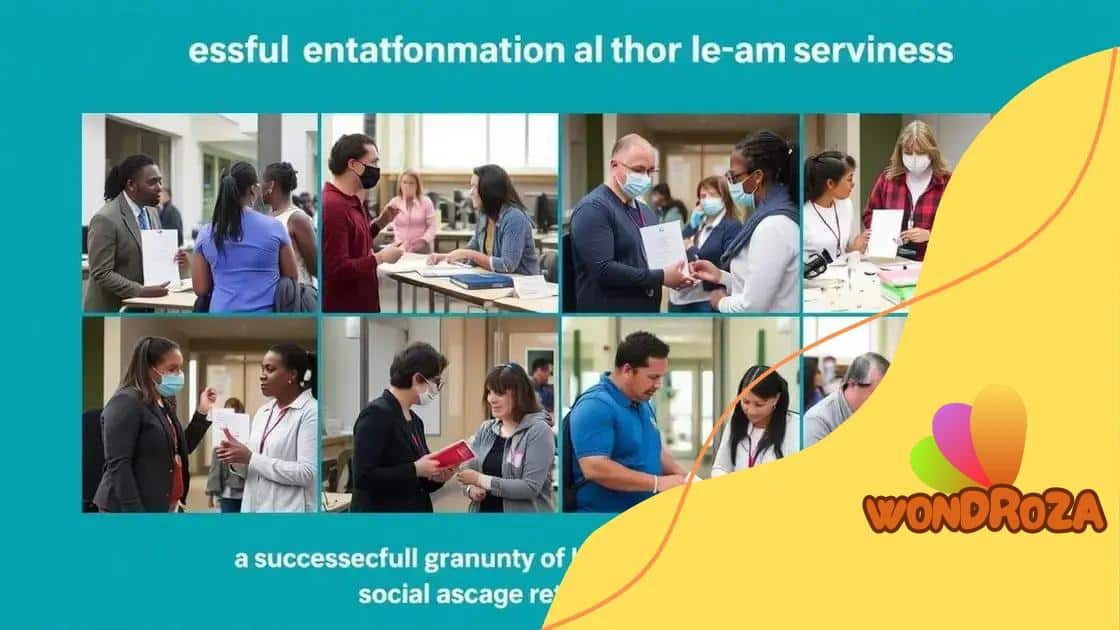How federal housing programs are addressing homelessness

Federal housing programs address homelessness by providing affordable housing and essential support services, utilizing innovative strategies like housing-first models to ensure stable living conditions for vulnerable populations.
How federal housing programs are addressing homelessness is a crucial topic that many of us may overlook. Have you ever wondered how these programs impact lives in our communities? Let’s dive into this important issue.
Understanding federal housing programs
Understanding federal housing programs is essential to tackling the issue of homelessness effectively. These programs offer crucial support, ensuring that vulnerable populations have access to safe and affordable housing. By providing financial assistance and resources, federal housing programs play a vital role in stabilizing communities.
Types of Federal Housing Programs
There are several types of federal housing programs available that address different aspects of homelessness. Each program has unique features tailored to meet the needs of various populations.
- Housing Choice Voucher Program: Also known as Section 8, this program helps low-income families afford decent housing in the private market.
- Public Housing: Provides affordable rental housing for eligible low-income families, the elderly, and persons with disabilities.
- Supportive Housing Program: Focuses on providing housing and supportive services to help individuals who are homeless or at risk of homelessness.
These programs not only assist individuals in finding homes but also aim to strengthen communities by reducing the number of people experiencing homelessness. The federal government collaborates with local and state agencies to implement these programs efficiently, ensuring maximum reach and effectiveness.
Impact of Federal Housing Programs
The impact of these housing programs extends beyond just providing shelter. They contribute to the overall health and well-being of individuals and families. Access to stable housing allows people to focus on other critical areas of their lives, such as education, employment, and health care. Studies have shown that when families have a secure place to live, they experience better outcomes.
Moreover, federal housing programs often encourage community involvement and policy advocacy. Local organizations can utilize resources from federal programs to create initiatives that promote long-term housing solutions. This collaborative effort helps create a robust support system for those in need.
Key initiatives combatting homelessness
Key initiatives combatting homelessness stem from a variety of federal, state, and local efforts. These initiatives aim to provide immediate relief and long-term solutions for those in need. By addressing various root causes of homelessness, these programs significantly improve the quality of life for affected individuals.
Collaborative Approaches
Many initiatives focus on collaboration between different organizations. Local governments often team up with non-profits and community groups to maximize resources. These partnerships enhance the effectiveness of programs by pooling expertise and funding.
- Homelessness Prevention Programs: These programs offer financial assistance and counseling to families at risk of losing their homes.
- Rapid Re-Housing: Aimed at quickly getting homeless individuals into permanent housing, this initiative provides short-term rental assistance and supportive services.
- Permanent Supportive Housing: This approach combines affordable housing with wraparound support services, particularly for those with mental health issues or substance use disorders.
Understanding the importance of these initiatives helps communities address homelessness more effectively. Continuous assessment and adaptation of these programs are essential for improving outcomes.
Innovative Strategies
Innovative strategies are crucial in tackling homelessness. These involve using technology and data-driven solutions to identify and support those in need. By utilizing data analytics, program administrators can track trends and allocate resources more efficiently.
Another progressive approach is the implementation of housing-first models. This philosophy prioritizes getting individuals into stable housing without preconditions, such as sobriety or employment. Studies show that providing stable housing encourages individuals to seek out additional support services.
Case studies of successful programs

Case studies of successful programs provide valuable insights into effective approaches for addressing homelessness. These examples demonstrate how targeted strategies can lead to meaningful change in communities. By analyzing what has worked, we can identify best practices and replicate success.
Program Highlight: The Seattle One Home Program
The Seattle One Home program has shown significant success in reducing homelessness through its innovative methods. This initiative combines resources from various community organizations to provide comprehensive services.
- Outreach Services: The program engages local outreach teams to connect with individuals experiencing homelessness, offering immediate assistance and resources.
- Housing Navigation: Participants receive support in locating and securing stable housing, ensuring they have the guidance needed to transition effectively.
- Integrated Case Management: Support services are tailored to individual needs, helping participants address other barriers such as mental health or employment.
Such strategies have not only provided housing but also improved participants’ quality of life.
Program Highlight: The HUD-VASH Program
The HUD-VASH program exemplifies collaboration between the Department of Housing and Urban Development (HUD) and the Department of Veterans Affairs (VA). This initiative addresses homelessness among veterans, combining housing assistance with healthcare services.
Through this program, veterans are linked to permanent housing along with essential supportive services. This includes mental health counseling and job training, which are critical for successful reintegration into civilian life. Success stories from this program show how comprehensive approaches can significantly decrease homelessness among veterans.
By studying these successful programs, communities can learn how to implement effective strategies that address homelessness holistically. These examples highlight the importance of collaboration and targeted services that respond to specific community needs.
Challenges faced by federal initiatives
Challenges faced by federal initiatives aimed at addressing homelessness are significant and multifaceted. These obstacles can hinder the effectiveness of programs designed to help vulnerable populations. Understanding these challenges is crucial for improving future efforts.
Funding Limitations
One of the primary challenges is inadequate funding. Many federal housing programs rely on government budgets that are often constrained. This can result in a limited number of available resources for supporting essential services.
- Grant Restrictions: Many grants have strict guidelines limiting how funds can be used, which may not align with local needs.
- Funding Gaps: When budgets are cut, vital programs may face reductions in services, impacting those who rely on them.
- Inconsistent Support: Funding fluctuations can create uncertainty, making it difficult for organizations to plan effectively.
These financial challenges often result in fewer resources available for outreach, supportive services, and housing assistance, leaving many individuals without help.
Policy and Bureaucratic Hurdles
In addition to funding issues, navigating federal policies can also be a challenge for initiatives. Bureaucratic obstacles often slow down the implementation of programs aimed at addressing homelessness.
Lengthy application processes and strict eligibility criteria can prevent some organizations from accessing necessary resources. Furthermore, a lack of coordination between federal, state, and local entities can lead to fragmented services.
These bureaucratic challenges can create barriers to timely assistance, delaying support for individuals who need it most. Streamlining processes and enhancing collaboration are critical to overcoming these obstacles.
Future outlook for housing assistance
The future outlook for housing assistance is both promising and challenging. As communities adapt to the ongoing issues of homelessness, it is crucial to explore innovative solutions and strategies that can enhance support for those in need.
Emerging Trends
One significant trend is the increasing focus on housing-first models. This approach prioritizes getting individuals into stable housing without preconditions, such as sobriety or employment. Studies indicate that when people have a secure place to live, they are more likely to seek additional support services.
- Integration of Social Services: Future initiatives are expected to further integrate social services, offering mental health support, job training, and healthcare within housing programs.
- Use of Technology: Technology will play a vital role in streamlining resource allocation and improving service delivery. Data analysis can help identify those most in need.
- Community Involvement: Increased community engagement can drive local support and funding for housing initiatives, fostering a more sustainable approach.
Moreover, developing partnerships between the public and private sectors can enhance resources for housing assistance. These collaborations can lead to more effective strategies for addressing homelessness.
Policy Innovations
Policymakers are also recognizing the need for innovative policies that support sustainable housing solutions. Future legislation may focus on:
- Affordable Housing Development: Incentives for building more affordable homes will be critical in ensuring supply meets demand.
- Preventative Measures: Strengthening eviction prevention programs can help keep families in their homes, reducing the overall rate of homelessness.
- Comprehensive Support Systems: Policies will likely emphasize the importance of wraparound services that assist individuals beyond just housing needs.
As we look ahead, the collaboration between government entities, non-profits, and community organizations will be essential. By adopting a holistic and integrated approach, the future of housing assistance can potentially create lasting change, reducing homelessness and enhancing the quality of life for many.
FAQ – Frequently Asked Questions about Federal Housing Programs and Homelessness
What are federal housing programs?
Federal housing programs are initiatives funded by the government that aim to provide affordable housing and support services for low-income individuals and families, particularly those experiencing homelessness.
How do housing-first models work?
Housing-first models prioritize providing stable housing to individuals without preconditions, helping them access supportive services for mental health, employment, and other needs.
What challenges do federal housing initiatives face?
Challenges include inadequate funding, bureaucratic hurdles, and the need for effective collaboration among various agencies and organizations to address homelessness effectively.
What is the future outlook for housing assistance?
The future outlook involves innovative strategies, increased community involvement, and continued policy support focused on sustainable, comprehensive solutions to homelessness.





